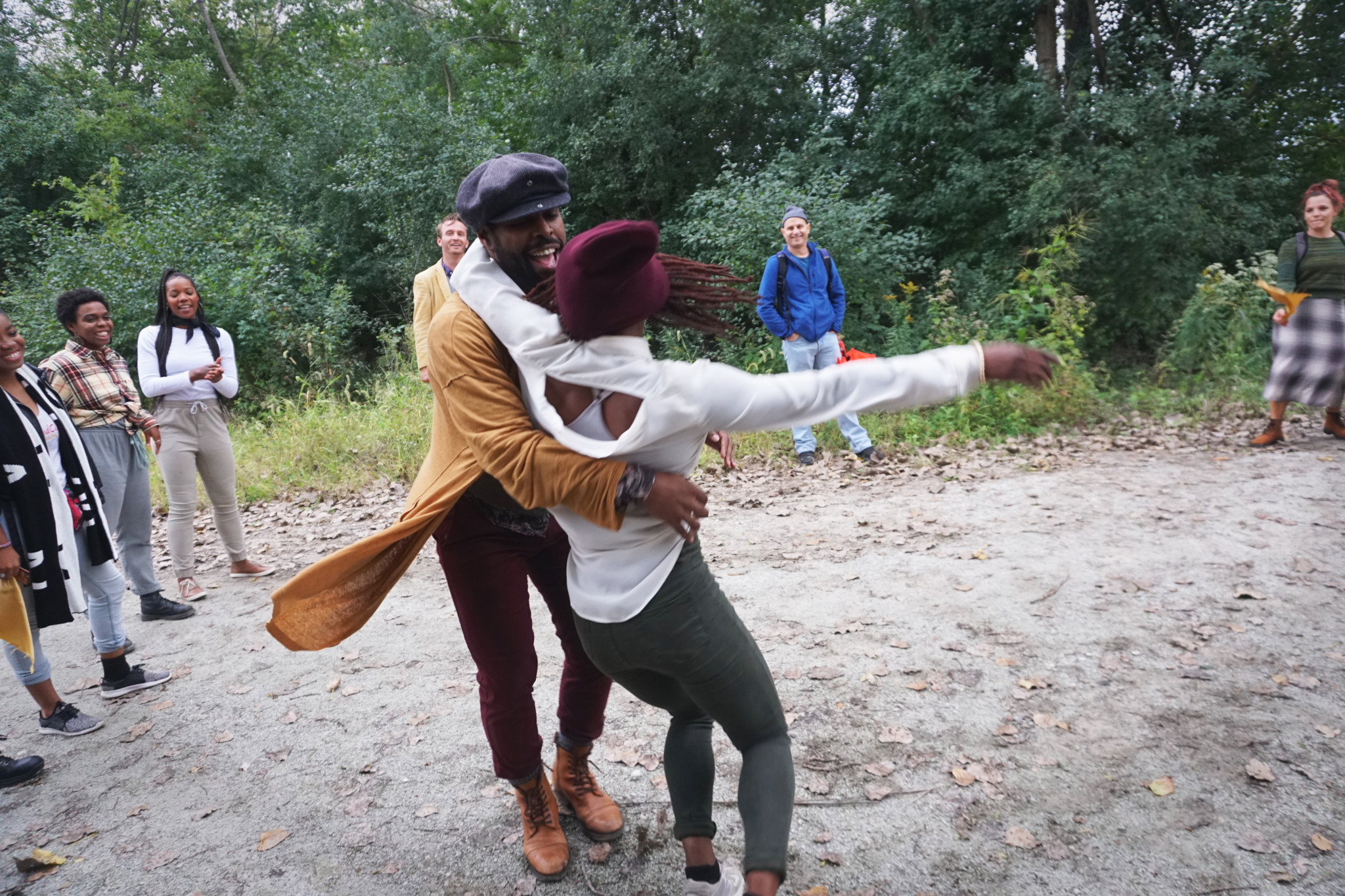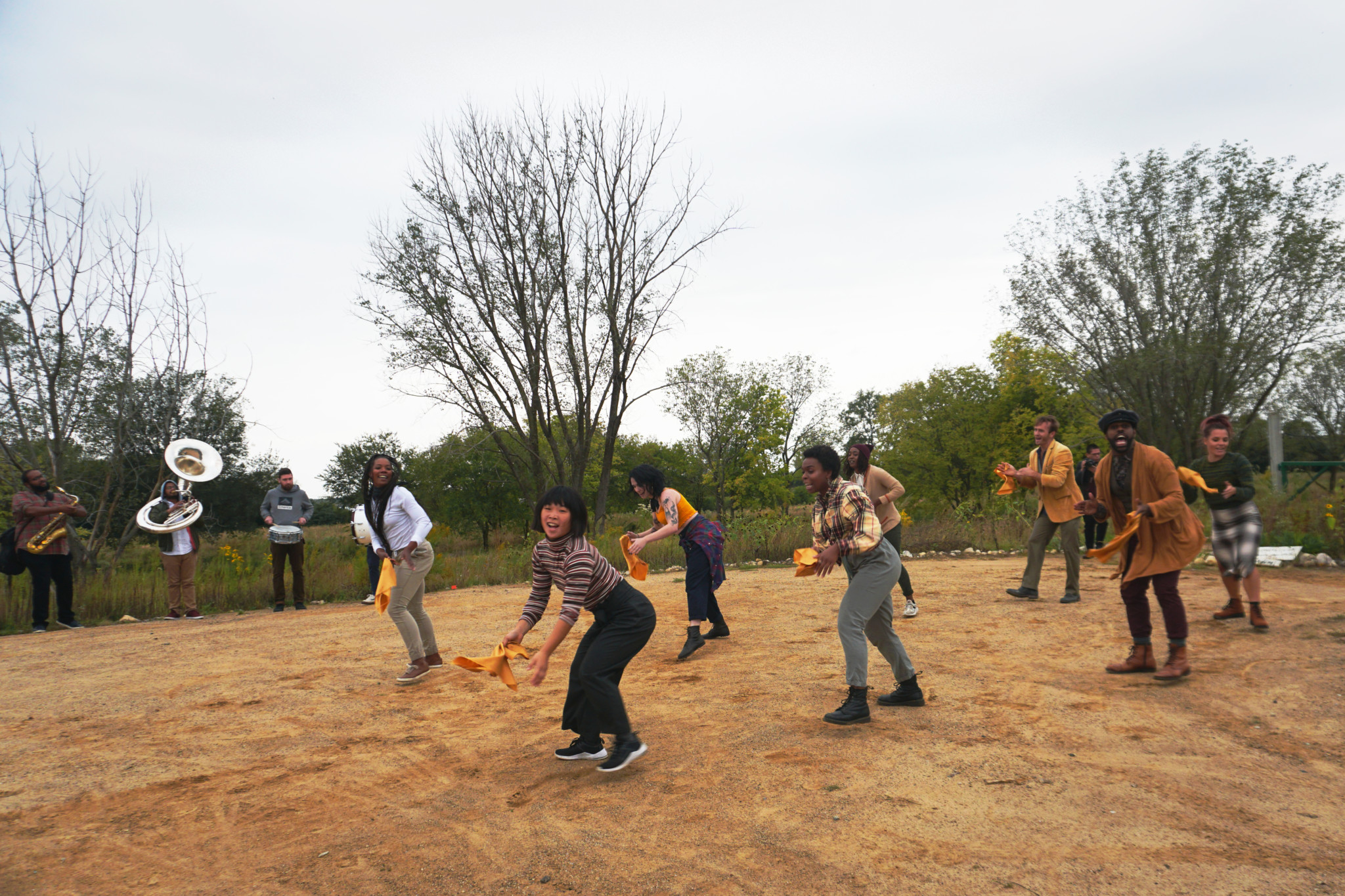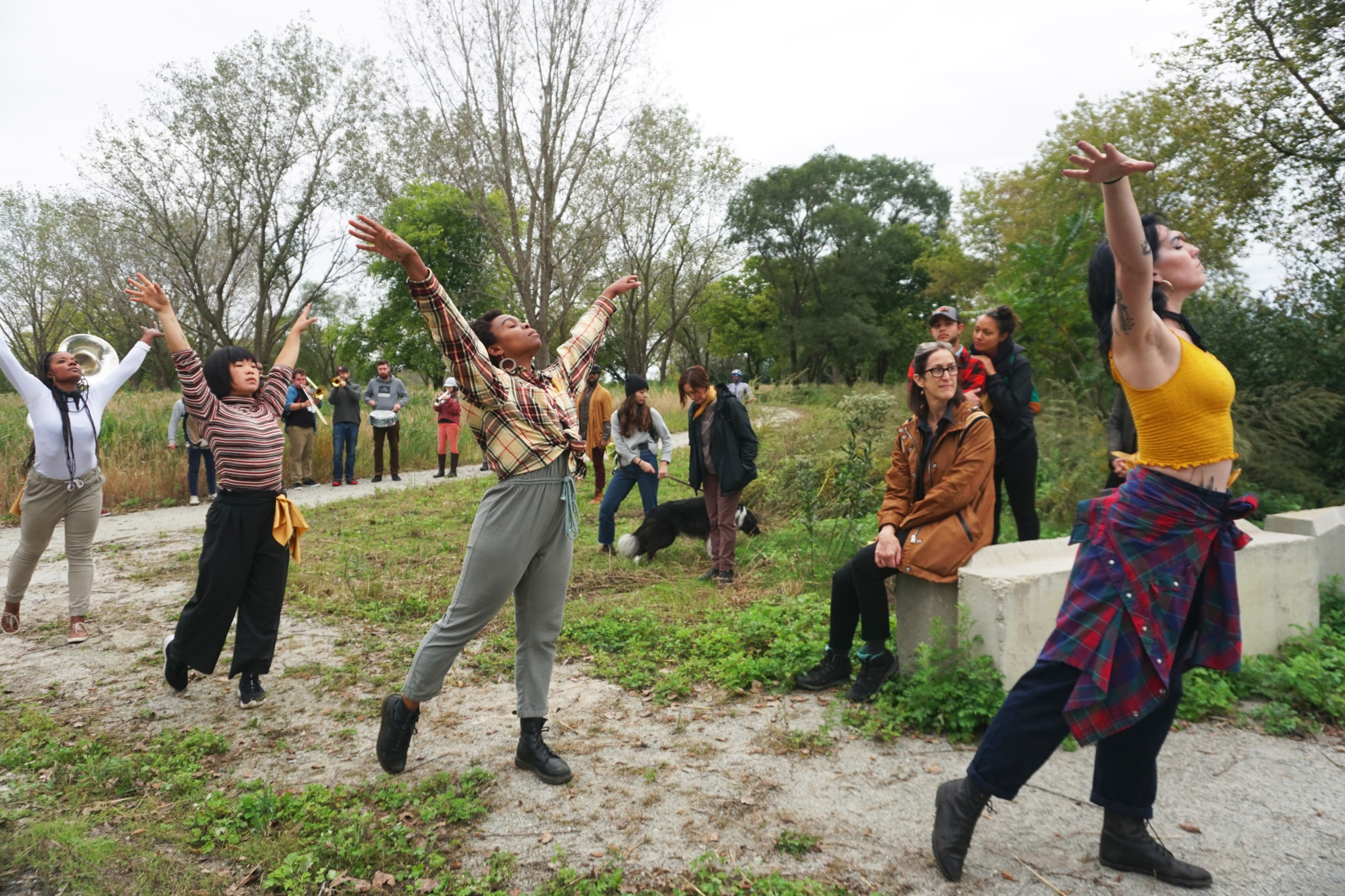City parks on Chicago’s Southeast Side became an unusual stage this fall, when Chicago Dancemakers Forum teamed up with the Park District’s Night Out in the Parks initiative to bring dance outside. This past weekend saw the last of three performances in the Natural Encounters series, each inviting audience members to explore nature areas through dance. “CYCLE,” choreographed by Erin Kilmurray and performed by seven dancers and a seven-piece band, took audience members on a walk around Big Marsh Park on a rainy Saturday afternoon.
About twenty minutes after the posted start time, a crowd gathered near the entrance of the park, braving a soft early autumn rain. Audience members ranged from young to old. Some were accompanied by several dogs, making it clear this would not be a traditional dance piece, but instead a focus on participation and engagement with the surrounding landscape.
Before the piece began, Kilmurray taught the audience a simple four-step move, which appeared several times in the choreography. First you put your right foot down then clap, left foot down and clap, step back with your right foot and clap, and then step back with your left foot and clap, repeating. It was accompanied by the call, “Move everybody, everybody get up,” borrowed from local group LowDown Brass Band’s song of the same name. John Cicora, band leader and bass drum player, would call this out periodically, leading a seven-piece band: Rajiv Halim on saxophone, Matt Kowalski on trombone, Melissa Neff and Constantine Alexander on trumpet, Neil Hemphill on snare drum, and Akshat Jain on sousaphone.
Choreographed as a kind of procession, the tone—of dance as well as the band—ranged from celebratory to mournful, telling the story of the land’s pollution and rehabilitation.
Dancing of any kind at Big Marsh Park would have been unthinkable just two decades ago. For most of the 1900s, the site was owned by Acme Steel and used as a dump site for the by-products of the steelmaking process. Acme’s coking plant, one of the largest remaining monuments to the city’s steel industry, still towers over the park to the east. After steel moved on, the site was owned by Waste Management, before it was acquired by the City and passed off to the Park District in 2011.
By the time CPD took over , the marsh had become overrun with invasive species, with the ponds choked by reeds and cattails. Debris had severed the connection to Lake Calumet, explained Dr. Lauren Umek, an urban ecologist and project manager for CPD.
A plan to restore the habitat and build an eco-recreation park was developed in 2014, and two years ago, the park opened up to the public with a bike park, a new walking trail and a parking lot. While the ground has been capped with clay and the space is safe for visitors, visible remnants of the industry are still present, like an abandoned staircase and various deteriorated structures. About forty-five of its 280 acres are available for hiking and off-road biking, with other space for birdwatching and walking. The Ford Calumet Environmental Center, an educational and programming hub for the Southeast Side’s natural areas, is expected to open in March 2020., The Park District hopes to restore parts of the park to a native prairie or savanna ecosystem.
Umek said the area is now able to support a thriving ecosystem. “In one season, you might find bald eagles, egrets, great blue herons, pelicans, sora, red tailed hawks, soft-shelled turtles, red-eared sliders, painted turtles and a whole assortment of butterflies, bees, and other otherwise unnoticed species. One local birder has identified over 190 different species of birds on site thus far and we only expect that number to grow as we continue to manage the space and increase the plant diversity.”
The park’s history of destruction and rebirth inspired Kilmurray when designing the dance performance. “Walking around the pathways made me think about different pathways, cycles, and loops that we could take performers and [the] audience on,” she said.
Kilmurray and Cicora developed the dance and music for the performance with New Orleans–style ritual mourning and celebration in mind. In this kind of procession, often called the second line, family members of the deceased and a hearse would make up the first line of a parade celebrating the life of the deceased, while a jazz band would follow closely behind.
After the church service, “the band plays a funeral dirge on the way to the burial site, and then they immediately kick into high gear, as [the procession] takes to the streets to party and celebrate the life,” Kilmurray elaborated. All of the songs in the performance were covers of songs by LowDown Brass Band, Louis Armstrong, Kashmere Stage Band and traditional New Orleans music.

Similarly, “CYCLE” audience members were handed triangles of golden fabric to wave around, which the dancers also used to lead the crowd down the winding path of the performance. Within an hour, the audience walked a loop, pausing to watch a solo or group choreographed moment from performers: Kilmurray, Josh Anderson, Kara Brody, Tia Greer, Alyssa Gregory, Breon Arzell Jackson, Sarah Ellen Miller, and Porscha Spells.
While the movement began upbeat, the ensemble brought the audience to a more reflective space in a secluded thicket along the marsh, where dancer Kara Brody danced along to Rajiv Halim’s slow saxophone solo. The foggy marsh and tall grasses provided a respite away from the crowded city. Audience members were rapt as the movements and sounds evoked the life that continued to thrive in the ecosystem of Big Marsh Park.
The mournful moments continued on the shores of the marsh, where four dancers approached and then eventually departed from an abandoned cement structure, of which only three sides were left buried in the ground. From there, dancers continued to lead the audience down the path, pausing to dance in open parts of the park.
This acknowledgement of the land’s history was an intentional part of the partnership between Night Out in the Parks and Chicago Dancemakers Forum. After Night out reached out to the Forum last spring, Big Marsh Park’s supervisor Stephen Bell provided a tour of each park, and the city asked the dancers to submit a proposal to receive grant funding. From there, leaders of Chicago Dancemakers Forum reached out to dance artists asking them to participate, and the performers created new works in the following months.
Since its founding in 2003, Chicago Dancemakers Forum has supported dance artists in the city through “artistic research and development of new work,” executive director Ginger Farley explained, including previous partnerships with the Chicago Park District and Night Out in the Parks. The two earlier pieces in the Natural Encounter series included “Dances for this Land” directed by Nejla Yatkin and Ayako Kato in Indian Ridge Marsh, and “Birds, Bugs and Tap” from Nico Rubio in Hegewisch Marsh.
Kilmurray toured Big Marsh in March and again in August, reaching out to dancers she had already worked with before, and taught them the piece just days before the show. While most sections were choreographed, some parts were intentionally left open for improvisation.
Breon Arzell, one of the dancers, said he enjoyed the process, and the relaxed tone of the piece spoke to the familiarity the dancers had with each other, and that the dance hopes to spark between the audience and the surrounding environment. The dancers didn’t seem to be wearing any coordinated costumes, instead wearing more or less street clothes, and there was no strict line between audience and performer; at points they would laugh or hug audience members they knew.

“A lot of times when you’re dancing with people it’s a lot about building trust, especially with things like lifts and assists,” Arzell explained. He knew Kilmurray from performing in her long-running Fly Honey Show, a feminist burlesque show that just closed out its tenth season at the Den Theatre. “But we’ve all danced together or known each other so we trust each other, so it was seamless. It was really easy to create because we all love dancing and we all love creating.”
He had never come to Big Marsh before, but definitely hopes to explore it more. “We only cover a fraction of all of this place is, and I didn’t even know it existed.”
Just like the title of the piece would suggest, the audience was led back to the same path where they started, this time invited to join in to a bigger, jovial celebration in the middle of the cement path.
“We were a little disruptive, hope it’s okay. The silence will be all the more palpable,” Kilmurray said after the final, celebratory number, gesturing to the grasses sprawling behind her, getting polite chuckles from the audience.
The themes of death and rebirth really spoke to audience member Rosey Puloka. A local dance and movement therapist who has danced with Kilmurray before, she had never been to the park, and was impressed by how Kilmurray creates a sense of place. “I appreciate that the people in the relationships that are on a land can change any land. This makes me feel like land is more possible to do things on,” she said. “Erin is bringing celebration into death. It felt more like a cycle.”
Farley was particularly excited about this project, having directed her own site-specific works in years past. She also says this partnership is indicative of the priorities that Chicago Dancemakers Forum try to spearhead. “We’ve been working to respond to the things we hear from dance making artists, in that they want to get their work into different kinds of spaces, to cross over into different kinds of audiences,” she explained. For this piece, the organization also reached out to the Nature Conservancy, Experimental Station, and Blackstone Bicycle Works to engage a wider audience. [Ed. note: Experimental Station is the Weekly’s fiscal sponsor and landlord, and also houses Blackstone Bicycle Works.]
Paul Fitzgerald, executive director of Friends of Big Marsh, was eager to involve the organization in the process of the piece, seeing it as another way to engage the surrounding community. Friends of Big Marsh had already been trying to encourage residents to see the area as a social as well as environmental opportunity, from hosting events like barbecues, DJs, movie nights and even choir concerts. “So much of the Lake Calumet area was built for heavy industry in the last hundred years. We want to make sure that we can build it for people as well,” he said.
For their part, Gelasia Croom said the Nature Conservancy has also branched out to engage residents in different ways to get in contact with nature. “We used to be more about nature for nature’s sake,” she said, explaining how the organization now tries to focus on grassroots efforts to make natural areas more accessible for more people.
The dancers shared that ethic, too. “I prefer thinking of it as a performance event rather than a dance, because there’s so much more than just seeing the dance that it is. It’s still happening,” Kilmurray said, gesturing to the grill provided by Friends of Big Marsh. Though the rain eventually drove some people away, audience members stuck around to hug and congratulate the performers, and eat burgers. Some of them even took up Divvy bikes or walked the path again.
Following the local organizations’ leads of broadening the experience of nature as universal, Arzell saw CYCLE as a depiction of the connection between life and dance. “We as humans, we are naturally movers and dancers,” Arzell said. “You can dance, everybody can dance, that’s why we’re on two legs. Everything we do is dance. This [piece] awakens that in people and makes them realize that dance doesn’t have to be [divided into audience, stage and performer]. It’s immersive.”
Amelia Diehl is a writer and climate justice organizer originally from Ann Arbor, Michigan. She last wrote for the Weekly about the environmental justice mayoral forum.



